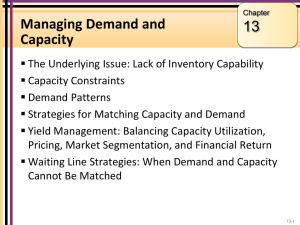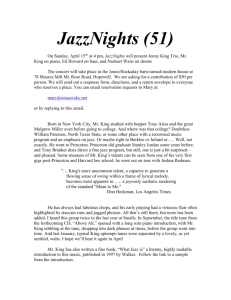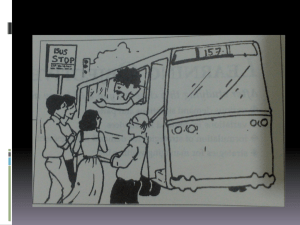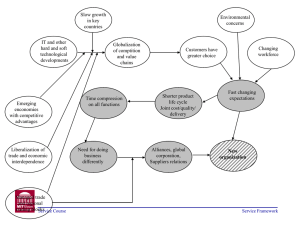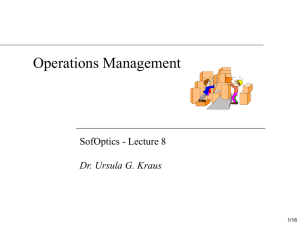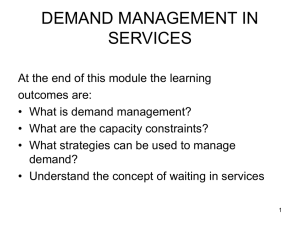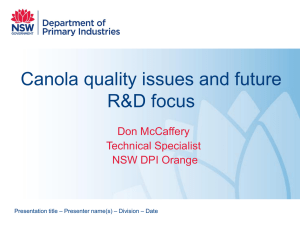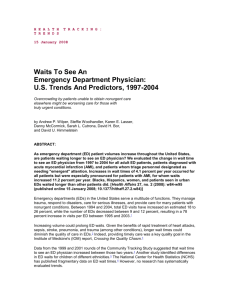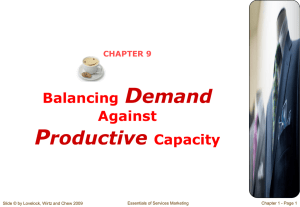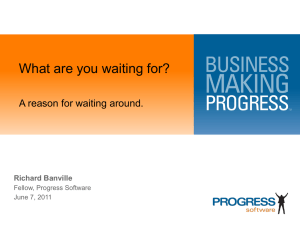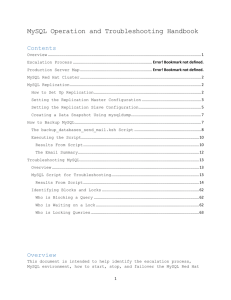Managing Supply and Demand
advertisement
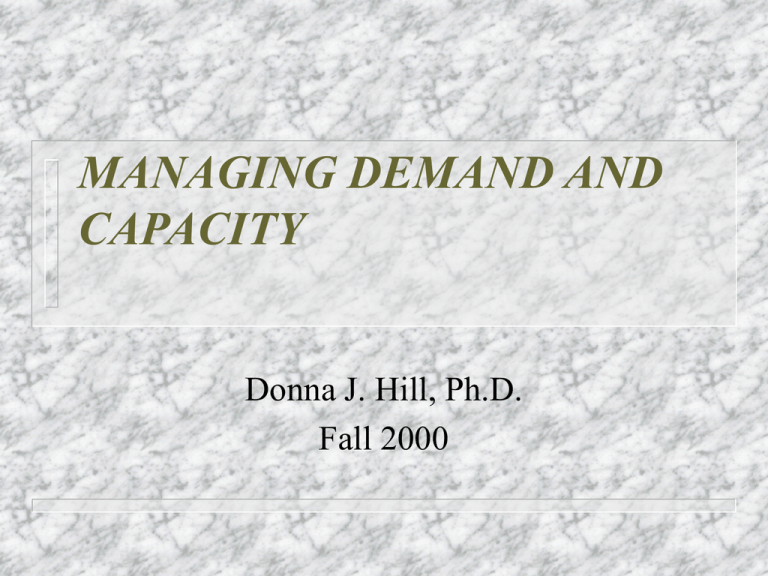
MANAGING DEMAND AND CAPACITY Donna J. Hill, Ph.D. Fall 2000 • Objectives for Chapter 14: Managing Demand and Capacity Explain: • the underlying issue for capacity-constrained services • the implications of capacity constraints • the implications of different types of demand patterns on matching supply and demand • Lay out strategies for matching supply and demand through: • shifting demand to match capacity or • flexing capacity to meet demand • Demonstrate the benefits and risks of yield management strategies • Provide strategies for managing waiting lines Fundamental Issue Lack of inventory – – perishability (cannot store up) simultaneous product and consumption (cannot be transported from one place to another) Managing Demand and Capacity No buffer for services from demand. Demand volatile Goal: supply and demand balanced at optimum capacity Under utilizing when demand is below optimum capacity If demand is above capacity then quality may suffer Matching Supply and Demand Determine demand pattern. Assess causes of demand variations. Develop methods for managing capacity. Develop methods for managing demand. Table 14-1 What is the Nature of Demand Relative to Supply? Extent of demand fluctuations over time Extent to which supply is constrained Wide Peak demand can 1 usually be met Electricity without a major Natural gas delay Telephone Hospital maternity unit Police and fire emergencies Peak demand regularly exceeds capacity 4 Accounting and tax preparation Passenger transportation Hotels and motels Restaurants Theaters Narrow 2 Insurance Legal services Banking Laundry and dry cleaning 3 Services similar to those in 2 but which have insufficient capacity for their base level of business Source: Christopher H. Lovelock, “Classifying Services to Gain Strategic Marketing Insights,” Journal of Marketing, 47, 3 (Summer 1983): 17. Understanding Capacity Constraints and Demand Patterns Capacity Constraints Time, labor, equipment and facilities Optimal versus maximal use of capacity Demand Patterns • Charting demand patterns • Predictable cycles • Random demand fluctuations • Demand patterns by market segment Table 14-2 What is the Constraint on Capacity? Nature of the constraint Type of service Time Legal Consulting Accounting Medical Labor Law firm Accounting firm Consulting firm Health clinic Equipment Delivery services Telecommunication Utilities Health club Facilities Hotels Restaurants Hospitals Airlines Schools Theaters Churches Managing Demand Shift demand from high to low demand periods. Decrease demand during peak demand periods. Stimulate demand during low demand periods. Figure 14-3 Strategies for Shifting Demand to Match Capacity Demand Too High • • • • • Shift Demand Use signage to communicate busy days and times Offer incentives to customers for usage during non-peak times Take care of loyal or regular customers first Advertise peak usage times and benefits of non-peak use Charge full price for the service--no discounts • • • • • Demand Too Low Use sales and advertising to increase business from current market segments Modify the service offering to appeal to new market segments Offer discounts or price reductions Modify hours of operation Bring the service to the customer Shifting Demand Advantages Business is not lost. Service quality is not adversely affected. Increased efficiency. Disadvantages Customers may not want to shift. Customers may not have control over when they use the service. Reducing Demand Advantages Service quality is normally improved. Increased efficiency. Disadvantages Lost revenue. Not a good strategy for firms in the forprofit sector. Stimulating Demand Advantages Increased efficiency. Increased income. Increased utilization of facility. Disadvantages May not be profitable. May cause some current customers to shift usage. Tools for Managing Demand Reservation system. Differential pricing. Communication Managing Capacity Part-time employees. Employees work overtime. Peak-time operating procedures. Cross-training of employees. Increase customer participation. Shared facilities. Outsourcing. Figure 14-4 Strategies for Flexing Capacity to Match Demand Demand Too High • • • • • • • Flex Capacity Stretch time, labor, facilities and equipment Cross-train employees Hire part-time employees Request overtime work from employees Rent or share facilities Rent or share equipment Subcontract or outsource activities • • • • Demand Too Low Perform maintenance renovations Schedule vacations Schedule employee training Lay off employees Part-time Employees Benefits Reduce costs. Increase capacity. Concerns Less training. Lower performance. Lower productivity. Poor attitude. Less knowledgeable. Less personalization. Higher turnover. Employees Work Over-time Benefits Employees knowledgeable. Employees know customers. Cost effective for some services. Increase capacity. Concerns Lower service quality due to fatigue. Higher costs. Peak-time Operating Procedures Benefits Keep operations at capacity. Concerns Identifying peak routines. Lack of personal attention. Incomplete job. Crowded facility. Feeling of being cheated. Cross-Training of Employees Benefits Keep operation at capacity. Reduce bottlenecks. Fill-in for absent employees. Concerns Lower service quality. Lower productivity. Increased Customer Participation Benefits Increase productivity. Maximize capacity. Reduce costs. Concerns Customers lack expertise. Conflict of scripts. Lower service quality. Sometimes decrease productivity - if customer too slow. Shared Facilities or Equipment Benefits Reduce capital investment costs. Maximize facility utilization. Concerns Efficient scheduling. Access to facility or equipment. Customer confusion. Outsourcing Benefits Expand capacity. Expand supply. Concerns Level of service quality. Stealing of customers. Conflicts as to who was hired. Yield Management The process of allocating the right type of capacity to the right kind of customer at the right price so as to maximize revenue. Yield = Actual revenue/Potential revenue Where actual revenue = actual capacity used times average actual price and Potential revenue = total capacity times maximum price What does it mean? Yield can be raised by increasing capacity used or by increasing price. It is basically a differential capacity allocation and pricing strategy Yield management strategy is most profitable when those who arrive early or reserve early are more price sensitive than those who reserve or arrive late. Risks Associated with the Use of Yield Management The loss of competitive focus Customer alienation Incompatible incentive and reward systems Employee morale problems Waiting Line Issues and Strategies unoccupied time feels longer preprocess waits feel longer anxiety makes waits seem longer uncertain waits seem longer than finite waits unexplained waits seem longer unfair waits feel longer longer waits are more acceptable for “valuable” services solo waits feel longer
